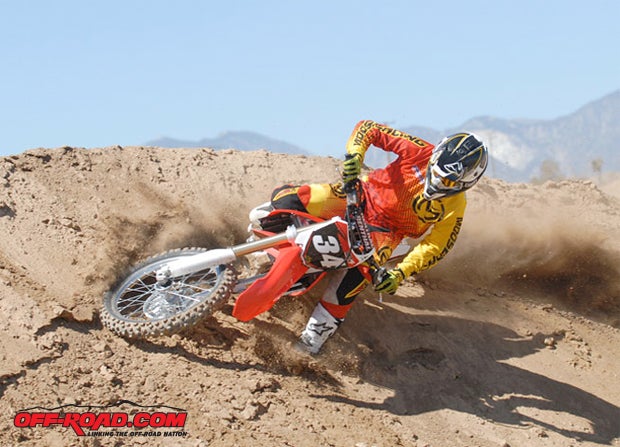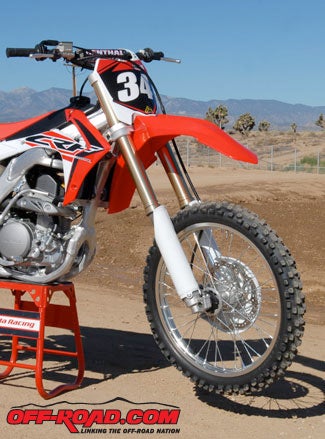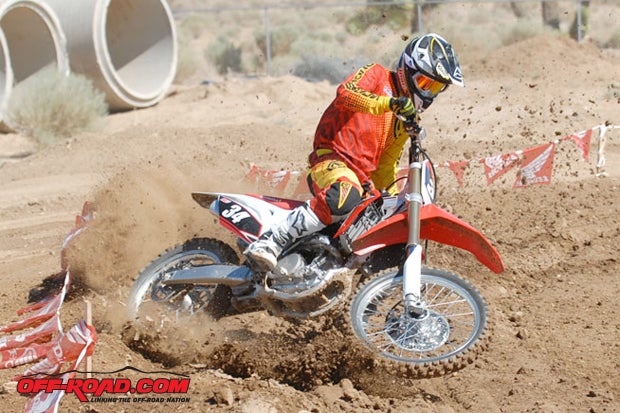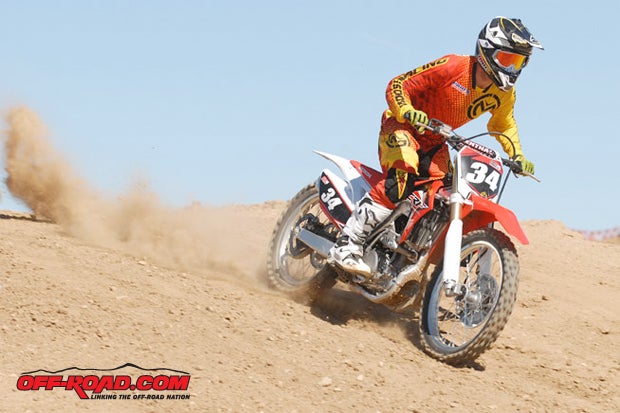Review: 2015 Honda CRF250R
We put Big Red's new CRF250R through its paces

That’s a bummer because the 2014 CRF250R was a very capable machine, and now that Honda’s 2015 model boasts key revisions that make it easier to dial-in, it deserves a second look.
The biggest changes to the 2015 CRF250R are centered around its liquid-cooled, fuel-injected, Unicam SOHC single-cylinder engine. Whereas the engine’s ECU was already reprogrammable to tailor its fuel and ignition curves to meet the demands of the track or rider preference, the 2015 makes that adjustment even easier. An all-new Engine Mode Button allows the rider to change fuel/ignition curves virtually on the fly—no more pulling into the pits to make a map change; it can be done trackside. The other big news is that the 2015 CRF250R’s suspension has also gone the route of its CRF450R sibling with introduction of a new-generation 49mm Showa Separate Function Fork, Triple Air Chamber (SFF-Air) fork.
Our chance to spin laps aboard the 2015 CRF250R at Competitive Edge Raceway in Hesperia, California, only served to reinforce the fact that CRF250R is an awesome machine with more than a sporting chance at beating the YZ250F.
The first thing we noticed is that the CRF250R’s motor is no slouch. Its oversquare 76.8mm x 53.8mm bore and stroke offer good low-end torque and a hearty mid-range punch for a 250cc, but it doesn’t possess as strong of a top-end rush as some of its competition. Honda engineers attempted to address the CRF250R’s power character with a new Unicam cylinder head and new piston last year, and it helped, but it wasn’t enough to dethrone the Yamaha in the horsepower wars. For 2015, Honda’s engineers chose not to try and pull even more peak power out of the CRF250R. Instead, the goal was to unlock the existing design’s full potential via a new Engine Mode Button that offers the rider a choice of three EFI/ignition map settings to alter the power delivery to suit various track conditions.

Honda calls the Mode Select Button and industry-first—and it is, for dirtbikes. Basically the button is Honda’s “better idea” answer to the plug-in ignition modules found on the Kawasaki KX250 and Suzuki RM-Z250. The Honda system’s three modes include Mode 1, which is the stock ignition and fueling maps; Mode 2, which pulls timing and fuel away from the motor to make it more manageable in slick conditions; and Mode 3, which is the most aggressive and responsive maps, emphasizing more top-end power to drive through deep, soft terrain. To make the changes, the rider simply stops with the engine at idle and then depresses the button found next to the throttle on the handlebar, a blinking LED light signals which mode the rider is in—one blink for Mode 1, two rapid blinks for Mode 2, and three rapid blinks for Mode 3. It’s far less of a hassle than returning to the pits to replace a module, although the Honda still allows custom-tweaking of Modes 2 and 3 via HRC accessory mapping hardware and software; Mode 1, the stock setting, cannot be altered.
On the track, DBC’s expert test rider Ryan Abbatoye preferred the Honda in Mode 1, while others preferred Mode 3, the most aggressive mapping of the three. For heavier rider’s Mode 3 allows the CRF250R to hold a gear longer between shifts, and the fewer shifts you have to make around a motocross course, the generally easier it is to ride a given bike. We mutually agreed that Mode 2 simply robbed response and sapped the midrange too much for our tastes at the Competitive Edge track, although we can see its value for dry-slick or muddy courses.
Regardless of mode, the best way to characterize the CRF250R engine is that it favors smoothness over aggression. Throttle response through its Dual-Timing PGM-FI fuel injection system and 46mm Keihin throttle body is plenty crisp, but even in Mode 3 the engine doesn’t feel as brawny as others we have sampled. Experts may not be impressed by its polished character, but that doesn’t mean that the Honda is weak by any means. It certainly sounds mean enough when you’re up on the cams, but that’s partially because Honda redesigned the 2015 250R’s dual mufflers by increasing the right-side outlet diameter from 22 to 23.8mm and the left-side outlet diameter from 23.4 to 26.6mm.
The actual power is still focused in the middle, however, and we wish that the Honda had just a little more top-end overrev. At least the action from its clutch and five-speed transmission are superb, in case you do find yourself short-shifting the bike to stay in the meat of the powerband. Abbatoye’s only real gripe was that he felt as if he needed to land off jumps on the gas in order to keep the CRF driving at high rpm.

But whatever it gives away on the top end, the CRF250R might well be able to make up in the corners and when the going gets really rough. Its aluminum perimeter frame steers with precision, and its low center of gravity really lets the CRF250R hunker down in ruts or berms. Its 58.6-inch wheelbase, 27 degrees of rake and 4.6 inches of trail are unchanged from 2014, and changes made to the subframe and airbox last year still contribute to its compact and small feel. That allows the rider to climb all over the bike and put his or her weight were it is most effective to hustle the CRF250R around any bend, whether bermed, flat or off-camber. But some of our testers noted that they were catching their knees on the CRF’s pointy radiator shrouds, and we learned from Honda insiders that some factory race team riders their shrouds inward with zipties for that very reason.
The CRF250R also joins the “air force” for 2015, shedding its Showa Separate Function Fork (SFF) in favor of a new-generation 49mm Showa Separate Function Fork, Triple Air Chamber (SFF-Air) air fork. Since there are no coil springs in the fork the SFF-Air sheds 2.8 lbs. of weight from the bike while also claiming to offer a wider range of adjustment than a conventional spring fork. The right fork leg houses the damper mechanisms for compression and rebound control, while the left fork leg contains a three-chamber pneumatic spring system.
Honda says that the new SFF-Air offers a huge degree of adjustability in damper settings, with 16-position rebound and 16-position compression damping adjustability as well as spring rate adjustability. In the left fork leg, the balance chamber affects the spring rate at the initial portion of fork travel and at low speed, while the inner chamber affects spring rate throughout the entire range of fork travel. The outer chamber contains fork oil and air at ambient pressure; adjusting the level of oil in this CRF250R-Dchamber only affects the spring rate when the fork is almost completely compressed. Static sag and preload are changed by adjusting air pressure in the inner and balance chambers via a Schrader valve on the fork cap, and by changing the oil volume in the outer chamber. The pressures in the balance chamber and inner chamber can be fine-tuned at the track, using Honda’s accessory pump, to suit riding conditions. Honda also says that the SFF-Air uses such high-pressure settings—a maximum of 189 psi—that any increase in pressure that may occur as the fork heats up during use is negligible percentage change.
Out back, the CRF250R’s Showa piggyback reservoir single-shock gets a slightly stiffer and also lighter spring for 2015. The shock body itself is unchanged, offering 17-position rebound adjustment, along with 13-position low-speed and 3.5-turn high-speed compression damping adjustment.
We have yet to be completely won over by air forks in general because we see potential issues with their use in the off-road environment, a place where lots and lots of motocross machines end up spending the majority of their lives. That said, the CRF250R’s SFF-Air is a definite improvement over the SFF on last year’s model. It takes a while to get used to adjusting it, and Honda officials warned us that constantly fuzzing with the air pressures as a way to dial-in compression and rebound compliance is not the correct procedure—use the clickers! One thing that we did notice, however, is that a single click on either the compression or rebound knob could be the difference between feeling perfectly dialed-in or floundering. But when it’s right, it’s right, and the fork offers tremendous feel over small ripples and excellent bottoming resistance over monster jumps.

All the while, the Honda’s Pro-Link rear end tracks straight and true through the whoops, ruts and square-edged bumps, working in concert Honda’s Progressive Steering Damper (HPSD). Attached to the lower triple clamp, the HPSD’s damping action progresses as the speed of the handlebar deflection increases to help the Honda retain its quick steering action while resisting head shake at high speed.
Coming down from speed is now supposed to be easier on the 2015 CRF250R, thanks to an increase in the front wave rotor size, from 240mm to 260mm. Honestly, we didn’t notice much of a difference in braking power, as last year’s 240mm front rotor was already excellent. Dunlop’s Geomax MX52 motocross front and rear tires are also new on the Honda for 2015. Designed to excel on intermediate/hard surfaces, they work well across a wide spectrum of off-road.
The CRF250R also has a different look for 2015, thanks to new fork covers that are claimed to offer better rock protection as well. The front brake guide, rear brake disc guard and and radiator grill are now finished in black to complement an all-new CRF graphics package.

The bottom line here is that the Honda CRF250R is definitely worth its $7599 asking price, which, oh yeah, just happens to be the exact same price as last year despite the new Engine Mode Button feature and more sophisticated SFF-Air fork. At the end of the day, we would love to get hold of a long-term model to see if couldn’t extract more top-end power out of the little Honda. But honestly, that’s all we would shoot for. The rest of the 2015 CRF250R’s package is already right on target.
2015 Honda CRF250R Specifications
MSRP: $7599
Engine Type: 249cc liquid-cooled single-cylinder four-stroke
Bore and Stroke: 76.8mm x 53.8mm
Compression Ratio: 13.5:1
Valve Train: Unicam®, four-valve; 30.5mm intake, titanium; 25mm exhaust, steel
Induction: Dual-Timing PGM-FI, 46mm throttle body
Ignition: Full transistor with electronic advance
Transmission: Close-ratio five-speed
Final Drive: #520 chain; 13T/49T
Suspension
Front: 49mm inverted Showa SFF-Air fork with 16-position rebound and 16-position compression damping adjustability; 12.2 inches travel
Rear: Pro-Link Showa single shock with adjustable spring preload, 17-position rebound damping adjustability, and compression damping adjustment separated into low-speed (13 positions) and high-speed (3.5 turns); 12.3 inches travel
Brakes
Front: Single 260mm wave-style disc with twin-piston caliper
Rear: Single 240mm wave-style disc
Tires
Front: Dunlop MX52 80/100-21
Rear: Dunlop MX52 100/90-19
Wheelbase: 58.6 inches
Rake: 27° 23’
Trail: 118mm (4.6 inches)
Seat Height: 37.4 inches
Ground Clearance: 12.7 inches
Fuel Capacity: 1.7 gallons
Color: Red
Claimed Curb Weight*: 231.0 pounds
*Includes all standard equipment, required fluids and full tank of fuel—ready to ride.


 Your Privacy Choices
Your Privacy Choices